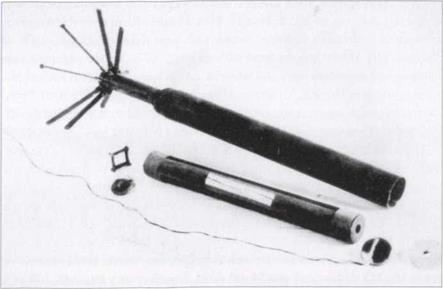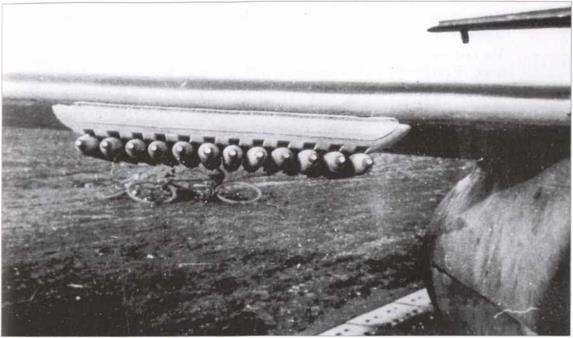R4M Orkan
The first rocket to engage heavy four-engined bombers was the 4-kg (8.8-lb) spin-stabilised solid-fuel R4M with folding tail-unit. It was designed at Osterode/Harz by the firm of Heber, and DWM of Liibeck-Schlutup. After short and highly encouraging trials, 20,000 were ordered almost immediately, but only 12,000 were turned out, the manufacturers being DWM, Schneider KG and LGW Hakenfelde. EKdo 25, later JGr 10 under Major Chrisd, carried out extensive tests proving that the R4M reached 540 m/sec (1,770 ft/sec) in only 0.8 seconds. Operational range was 500-600 metres. The mine-type warhead would bring down a heavy bomber even with a near-miss.
The first successful firing of an R4M was achieved from an Me 262 with a makeshift rack on 2 November 1944. The first use in action was on 18 March 1945 by JG 7. Between operational flights, the Knight’s Cross holder Oberstleutnant Heinz Bar, then commander of III./EJG 2 flew trials with an Me 262 fitted with a modified R4M firing rack. Because the rockets tended to jam in the rack, the installations were continually being modified even when carried operationally by Me 262s. On 31 March a Staffel, some of them equipped with R4M rockets, claimed 17 RAF Lancaster bombers.
 |
The R4M rocket was of great importance in the defence against Allied bombers. It weighed 4 kg, had solid-fuel propulsion and a mine warhead.

R4M racks were fitted to Ju 87 D-5s and Fw 190 D-9s as well as the Me 262 A-la, as seen here. The racks were of wood and therefore easy to manufacture in quantity.
On 5 April JGr 10, a test Gruppe and Messerschmitt works personnel were instructed to fit out 20 Me 262s of JV 44 at Munich-Riem with R4M racks to increase the aircraft’s fighting power, and even General Galland, JV 44 commanding officer, was credited with two kills of В-26 Marauder medium bombers just before the war’s end when he fired a salvo of 24 R4M rockets into a formation over Bavaria. An operation against a formation of 425 B-17 Flying Fortresses counts amongst the greatest victories achieved by the Me 262 fighter: 25 bombers were shot down by R4M rockets and MK 108 guns.
Experimental ‘automatic rockets’ (RA) which appeared just before the war’s end came too late. The racks with the firing gear were to be fitted below the wings of the Ar 234 or the forward section of the Me 262 fuselage. The engine works at Esslingen/Neckar produced several of the honeycomb-like devices for firing the R4M and other spin-stabilised rockets such as were fitted later to the Ba 349 Natter. At the capitulation only about 60 Me 262 fighters had been fitted with two simple racks with rails for eight, then twelve R4M rockets. Six other Me 262 A-las tried out 24-rail racks. Together with four MK 108 guns in the nose, this was a very successful combination of weapons for intercepting heavy bombers.










